“The organisers dubbed this race “Hell in Paradise”. I am sure that when they coined this phrase they never anticipated how right they would be.”
The 1994 Telecom Tasmania seven-day stage race lived up to its nickname in more ways than one. Eleven of the 27 starters didn’t make it to the finish and the runners who did encountered snow blizzards one day and gale force winds on another – both of which very nearly put an end to the race.
When Eleanor Robinson was inducted into the International Association of Ultrarunners (IAU) Hall of Fame in 2001, she was asked to choose her top ten performances. The Telecom Tasmania Run was the ninth in her list. Perhaps it was the very toughness of the race which prompted her to include it.
The race organisation
The seven stages of the Telecom Tasmania Run totalled 617km with daily distances between 76km and 99km. It was not a continuous relay but rather a series of races in different parts of the island, starting and finishing in Hobart, Tasmania’s capital city.
The race was held from Saturday 6th August to Friday 12th August. August is a winter month in Tasmania, with an average daily temperature range of 4-14 degrees celsius. The organiser, Alan Rider, an experienced ultra distance runner, had secured the support of the Tasmania Department of Tourism, Sport and Recreation and sponsorship from Telecom Tasmania.
In his detailed race report in the IAU Newsletter of September 1994, Malcolm Campbell, President of the IAU, commented that there was considerable media interest in the event, partly because of the quality of the field and partly because it marked Yiannis Kouros’s return to major international competition after an absence of nearly four years. The field included runners from Australia, Belgium, France, Germany, Great Britain, Greece, Hungary, Latvia, Russia, Slovenia and South Africa. The British runners were Eleanor Robinson and Erik Seedhouse.
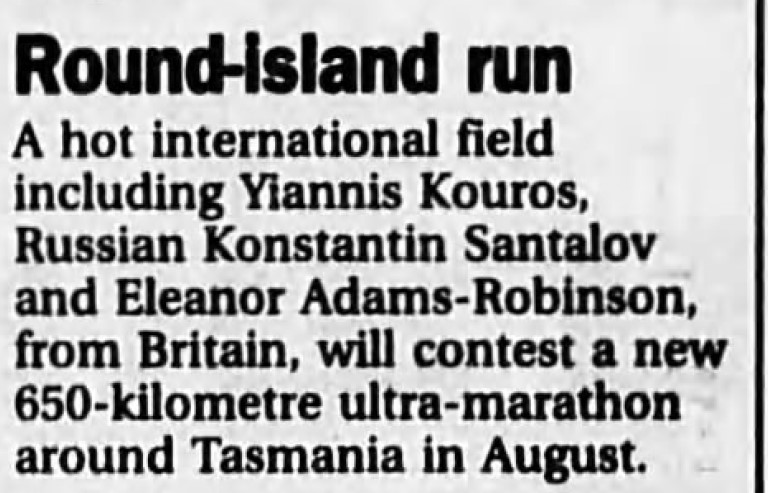
From the Victoria newspaper, The Age, 8th June 1994 (Newspapers.com)
Malcolm Campbell described the organisation of the race:
Every competitor had a support vehicle and crew and there were numerous official cars. In addition, an increasing number of media vehicles followed the race as a series of dramatic incidents occurred. Towards the final days of the race there must have been nearly 50 vehicles on this Tour of Tasmania.
There was daily coverage in the Tasmanian papers, the Examiner and the Mercury. In the lead-up, on 1st August, the Examiner, featured a four-page guide to the race. As the run progressed the headlines became increasingly dramatic.
The women’s field
Eleanor Robinson, was one of the top-class ultrarunners attracted to the event. That year she had competed in three ultras: the Barry 40 Mile track race in Wales finishing first woman, the IAU European 24 hour Championships in Szeged, Hungary, where she had finished seventh and the 100km Nacht van Vlaanderen in Torhout, Belgium, where she finished third.
Aged 46, Robinson had been winning ultras for 12 years and had set dozens of world records, many of them in Australia, where she had first competed in 1984 in the inaugural Colac Six Day Race.
Of the five female competitors, Malcolm Campbell judged 52-year-old Sigrid Lomsky of Germany and 20-year-old Irina Petrova of Russia to be Robinson’s main competition. Robinson held the 24 hour track record, Lomsky the 24 hour road record and Petrova was the Russian national champion.
Lomsky had won the IAU European 24 Hour Championships three consecutive times from 1992 to 1994 and the Spartathlon in 1993. She had also placed highly in several 100km races. Petrova was far less experienced than Lomsky and Robinson but had a formidable record of success. She had raced her first ultra aged just 18 and had completed eight 100km races finishing first in six of them. She finished third in the other two 100km races, earning a Bronze medal in the IAU 100k World Championships in Japan in June 1994.
The other two women in the race were experienced Australian ultrarunners Helen Stanger and Georgina McConnell. McConnell had competed against Robinson in the Melbourne 24 hour track race in 1989 where Robinson broken the world record.
Robinson was looking forward to returning to Tasmania and to the challenge of a stage race:
I was very excited by the prospect of this event. Stage racing requires a totally different strategy to other ultradistance events. It cuts out the sleep deprivation normally found in multiday races and enables the runners to perform at a much faster pace. It also makes for some exciting racing as competitors with no hope of overall success can push for the daily stage wins. To complete the course it is necessary to do just enough but not too much each day in order to survive.
I was familiar with the history of Tasmania and also the terrain as I had back-packed around the island some years earlier after one of the Colac races. I knew it to be mountainous but hoped that the climate would similar to that of a British summer as August would be the Australian winter. I had found it to be cool and wet during the 1989 Melbourne 24hr race.
My husband, Nigel, and young son, Myles (then two and a half years old), came out to crew for me. The field comprised a mixture of world class 100km runners and world class multi day runners. Which would triumph?
As with any other ultra event, my thoughts were primarily on completing the course. Each day would be taken as it came.
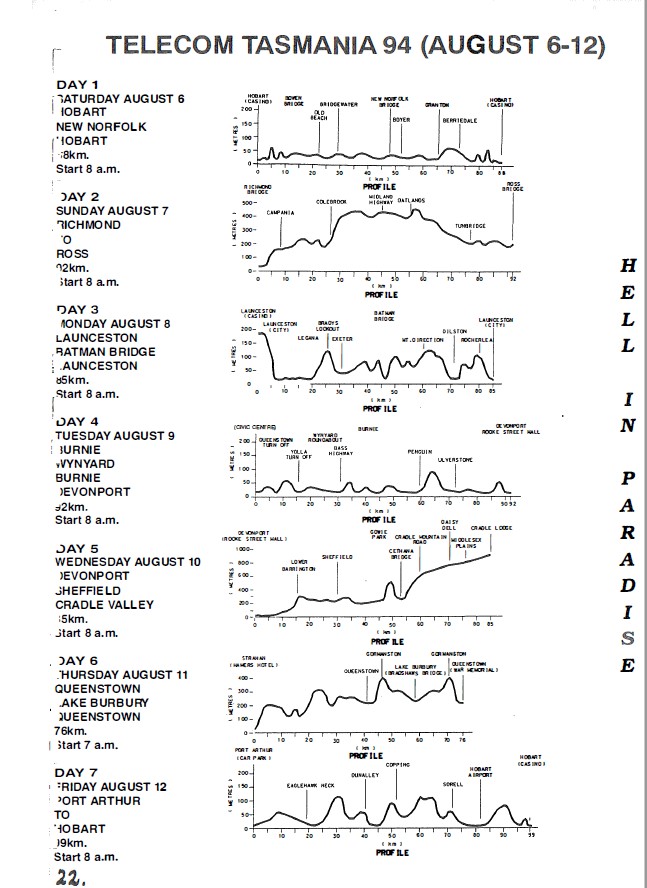
The race profile, from AURA Ultramag, December 1994
Day 1 – Hobart circular route – 88km
Eleanor Robinson wrote:
The start in Hobart was a 88km circular route and as usual I went out hard. There was a strong wind which disguised the temperatures and with 16km to go to the finish I began to feel the effects of dehydration. From a substantial lead I was overtaken in the final few strides to the finish line by Irina Petrova. I finished in a state of collapse and the inexperienced race organisers panicked and decided that I should be taken to hospital. There, after long delays, the doctors decided not to treat me but merely recommended 48 hours rest. Completely frustrated by losing my rest period, I discharged myself saying that I would rest after the race. The following day, much to our amusement, the press billboards carried posters declaring that I had been ‘close to death’.
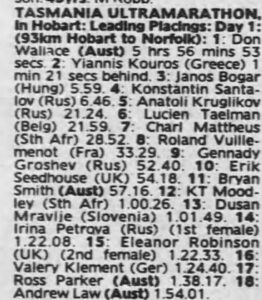
First day results, reported in the Sydney Morning Herald, 7th August (Newspapers.com)
Women’s stage winner – Irina Petrova, Russia
Men’s stage winner – Don Wallace, Australia
Day 2 – Richmond to Ross – 92km
Feeling much better the next day we all travelled out to Richmond to run 92km to Ross. The unthinkable happened and that day Tasmania saw the first snow for 10 years. It didn’t just snow though – we ran through terrific blizzards which closed roads and shut down the island. Fortunately, the race got through – just.
Many of the southern hemisphere athletes had never seen snow before. This was no Christmas card scene. This was serious winter weather. But although very cold and soaked to the skin, I had no chance of dehydrating and made a good recovery.
Malcolm Campbell wrote that “it became difficult to identify competitors as they became enclosed in white blankets of snow”. And “Petrova finished well ahead of Robinson with both runners looking comfortable.”
In the Tasmanian newspaper, the Mercury, John Briggs wrote: “Irina Petrova produced another amazing run to take a stranglehold on the women’s race, completely dominating her more experienced rival, Eleanor Robinson.”
Would Petrova be able to keep the lead or would Robinson or Lomsky overtake her?
Women’s stage winner – Irina Petrova
Men’s stage winner – Don Wallace
Day 3 – Launceston circular route via the Tamar Valley – 85km
Day 4 – Burnie- Wynyard – 92km
Robinson described the weather on these two days as “back to warm and sunny”. Campbell recorded that at the end of Day 3 Petrova finished well ahead of Robinson again, with her lead now 1 hour 41 minutes and 28 seconds.
On Day 4 she added to this, extending her lead by 44 minutes and 17 seconds.
Days 3 and 4 women’s stage winner – Irina Petrova, Russia
Day 3 men’s stage winner – Janos Bogar, Hungary
Day 4 men’s stage winner – Anatoli Kruglikov, Russia
Day 5 – Devonport to Cradle Mountain – 85km
The race profile shows that 55km into this stage, the route started to climb steeply. The runners ascended approximately 600m in the last 30 kilometres to reach the end of the stage at Cradle Mountain Lodge. It must have been cold in the mountains as the average maximum temperature in August is 6 degrees Celsius.
Robinson wrote:
Day 5 was to be the real test as we had 85km to run from Devonport up into Cradle Mountain. This was real wilderness and we faced very tough climbs to the Lodge. It was during this section that I overtook Petrova and began to relish the prospect of a gruelling battle to the finish. The end of that stage represented a battlefield as exhausted and hurt athletes were faced with a long drive to the start of the next day’s stage.
Three of the men retired on this day, adding to the six who had retired on Days 2 to 4. None of the five female competitors had retired at this point.
Campbell described Day 5 as pivotal in the race. Anatoli Kruglikov of Russia, the eventual winner, moved into a clear lead in the men’s race.
It was now time for Robinson to stamp her authority on the women’s race and she ran comfortably to pass Petrova and win the stage by 13 minutes. Her message to the Russian, who was more than 25 years’ younger, was clear, ‘I am still in this race and if you wish to beat me there is no easy way.’
Women’s stage winner – Eleanor Robinson
Men’s stage winner – Anatoli Kruglikov
Day 6 – Strahan – Queenstown – Lake Burbury – Queenstown – 76km
But Robinson was not going to get the close race against Petrova that she had expected:
For the first time since the start of the race, I led Petrova out of Strahan. Two more days to go. Now I could begin to race. Just as I was starting to plan my strategy, I received news that Petrova had pulled out with a severe shin injury. I was, by then, many hours in front of the next woman and could concentrate simply on getting to the finish line in Hobart.
Campbell commented that Petrova’s retirement which he said was due to an ankle injury “effectively handed the race to Robinson.” He suspected that psychological pressure may have played a role in the younger runner retiring from the race.
Women’s stage winner – Eleanor Robinson
Men’s stage winner – Pat Farmer, Australia
Day 7 – Port Arthur to Hobart – 99km
At the start of the day, both Robinson and Kruglikov had clear leads and Campbell described the stage as “a lap of honour” for them. However, there was more adverse weather to come:
With 5km to the end of the race, the runners were obliged to cross the Tasman Bridge which is about 1500 metres long. Gale force winds were blowing and the bridge was visibly swaying. The bridge walkway was exposed to the elements and most of the runners could only cross by holding on to the bridge handrail.
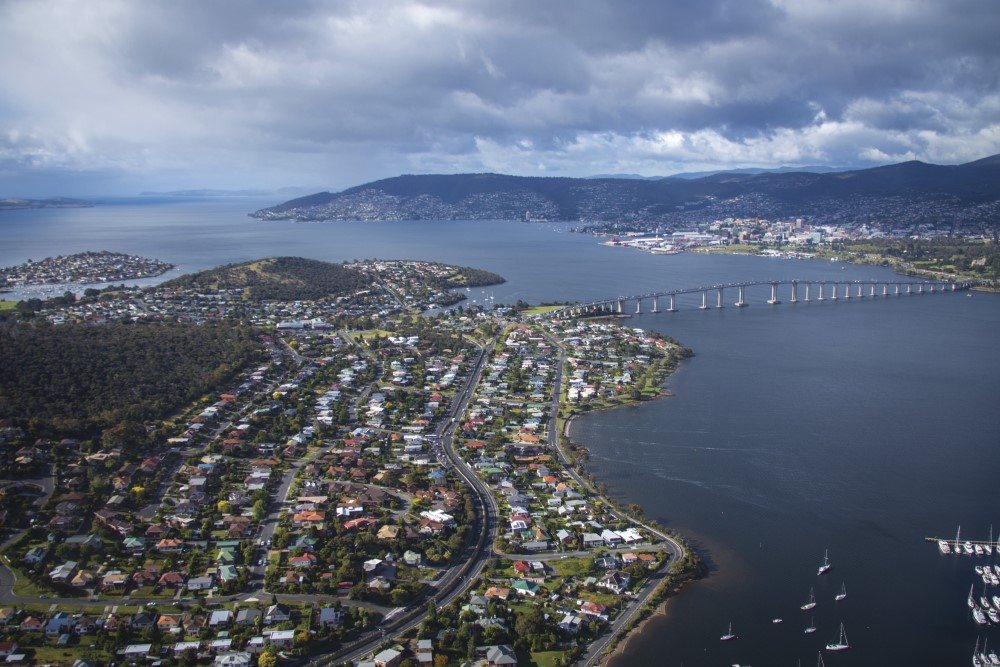
Eastern Shore, Tasman Bridge and Hobart, credit: Tourism Australia and Graham Freeman
Robinson wrote that the runners faced a gale-force headwind all the way and that they were escorted across the Tasman Bridge into Hobart “for fear that they might be blown off.”
Robinson finished the day two minutes ahead of Helen Stanger of Australia.
Her total time was 60 hours 31 minutes and 34 seconds and gave her ninth place overall out of 16 finishers. Robinson’s lead in the race was over 5 hours ahead of Stanger and over 7 hours ahead of Sigrid Lomsky. Georgina McConnell finished last in 76 hours 27 minutes and 39 seconds. It is notable that, whereas ten of the 22 men in the race withdrew, only one of the five women did.
Women’s stage winner – Eleanor Robinson
Men’s stage winner – Anatoli Kruglikov
Telecom Tasmania Run Results
| 1 | Anatoli Kruglikov (RUS) | 48:42:44 h |
| 2 | Yiannis Kouros (GRE) | 49:27:58 h |
| 3 | Bryan Smith (AUS) | 54:39:15 h |
| 4 | Dusan Mravlje (SLO) | 55:23:03 h |
| 5 | Gennady Groshev (RUS) | 56:22:07 h |
| 6 | Erik Seedhouse (GBR) | 56:50:47 h |
| 7 | Patrick Farmer (AUS) | 57:17:41 h |
| 8 | Valery Klement (GER) | 58:43:49 h |
| 9 | Eleanor Robinson (GBR) | 60:31:34 h |
| 10 | Georgis Jermolajevs (LAT) | 64:43:28 h |
| 11 | Kovalan Moodley (RSA) | 65:11:32 h |
| 12 | Helen Stanger (AUS) | 65:37:47 h |
| 13 | Roland Vuillemenot (FRA) | 66:19:32 h |
| 14 | Sigrid Lomsky (GER) | 67:53:31 h |
| 15 | Ross Parker (AUS) | 71:09:25 h |
| 16 | Georgina McConnell (AUS) | 76:27:39 h |
Conclusion
Robinson described the mood of celebration at the end of the race:
All the runners were suffering from injuries and exhaustion. Some hadn’t made it but those that did were justifiably proud of their achievement.
Although there were plans for the race to take place again the following year, it never did. Perhaps the memory of the 1994 weather conditions contributed to the race’s demise.
To give the last words to Eleanor Robinson:
“Hell in Paradise” – it certainly was.
…………………………………………….
Notes
Read about Eleanor Robinson’s other top ten performances:
1984 New York 6 Day Race
1984 Colac 6 Day Race
1986 Westfield Sydney to Melbourne Race
1987 The first Badwater Race
1989 Melbourne 24 Hour track race
1990 IAU International 24 Hour Championships Milton Keynes
1990 & 1991 IAU 100km World Championships
1998 Nanango 1000 Miles Track Race
and another race that did not make it into the top ten:
1983 The first Spartathlon
For a detailed account of the men’s Telecom Tasmania race, which had a number of dramatic turns, and three Australian stage wins, Malcolm Campbell’s report is available online here.
Sources
Interviews with Eleanor Robinson, June 2018 and May 2019
Articles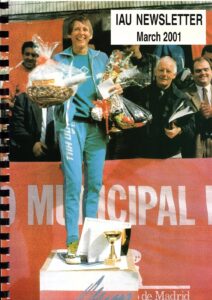 “Telecom Tasmania Run”, by Malcolm Campbell, IAU Newsletter, September 1994
“Telecom Tasmania Run”, by Malcolm Campbell, IAU Newsletter, September 1994
“My Top Ten Performances” by Eleanor Robinson, IAU Newsletter, March 2001
Australian Association of Ultrarunners (AURA) Ultramag, December 1994
Libraries Tasmania – Tasmanian newspaper indexes (for headlines of articles)
Results and records
Ultra Marathon Statistics, Deutsche Ultramarathon Vereinigung website
With thanks to Eleanor Robinson for lending me copies of the Road Runners Club and IAU Newsletters.
Banner photo: “Cradle Mountain, Tasmania” by Steven Penton is licensed under CC BY 2.0
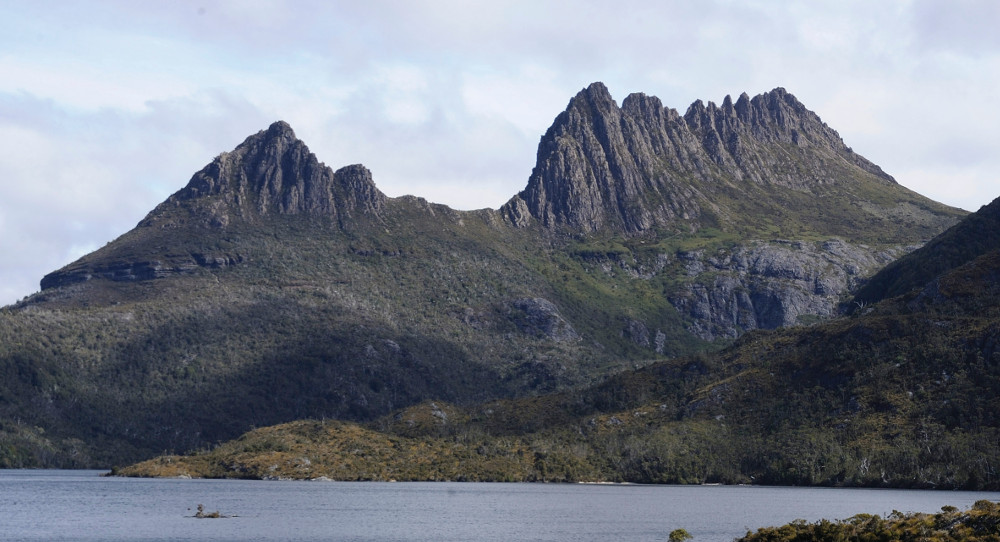
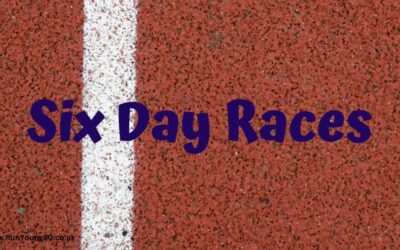
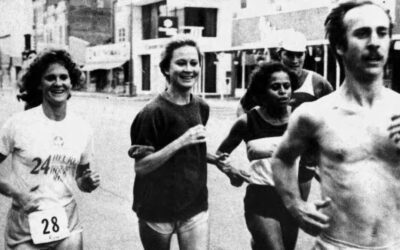
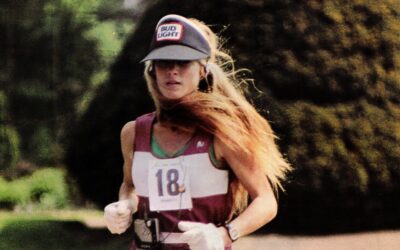
Incredible detail in this post – Yiannis Kouros,definately a name I’ve heard ofon somerunning podcasts.